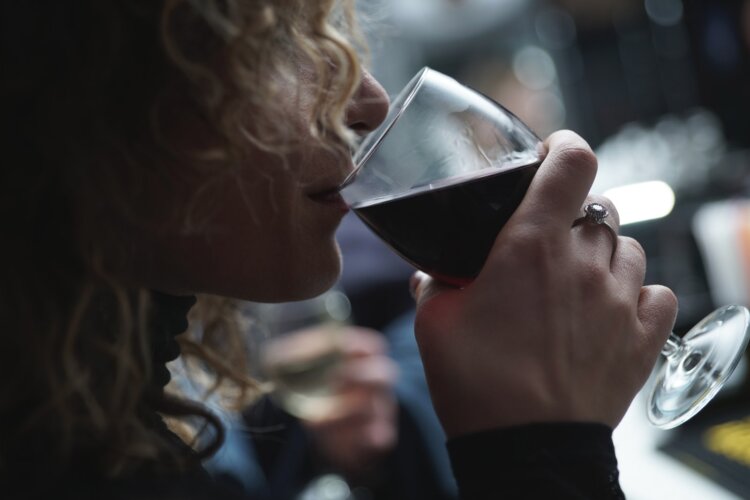
Do you have one too many vinos after a stressful day at work? If you’re anything like I was, you’ll start to notice the quantity of glass recycling piling up by the end of the week, but you won’t be worried enough to warrant actually doing anything about it. I often dismissed concerns by saying, “If you have a job like mine, you deserve three glasses of wine a day!” Back then, I thought that I had to reach the depths of despair to need help for my drinking habits. I thought I could stop whenever I wanted—until it was too late. At the end of my drinking, I was downing four bottles of wine a day and suffering clinical depression. I wish I’d known that I could’ve stopped earlier.
My history with alcohol started out as gray-area drinking—problematic drinking patterns that don’t meet a clinical definition of alcohol use disorder— and quickly progressed to alcohol use disorder. Drinking as a teenager was a way to blot out my unhappy childhood. I began to live for those moments of escape and couldn’t wait to drink a small bottle of vodka at the local park with my friends. And I wasn’t alone.
Gray-area drinking is more common than you might think. According to the National Institute on Alcohol Abuse and Alcoholism (NIAAA), 26.9 percent of people ages 18 or older reported in 2015 that they engaged in binge drinking in the past month; 7 percent reported that they engaged in heavy alcohol use in the past month.
Worse yet, 88,000 Americans die every year from alcohol use disorder, and a new study recently revealed there is no safe amount of alcohol to consume, yet NIAAA still recommends no more than three alcoholic drinks per day. The problem is that people rarely take these limits into account and don’t look at their overall consumption. As we see the normalization of drinking as a means to cope with life’s stressors—with wine being marketed as “liquid therapy” or “mommy fuel,” and yoga being sold as “vino vinyasa”—it is all the more common that our drinking progresses from a gray area to a disorder.
In a study assessing the potential harm of gray-area drinking, researchers found that the gray area of consumption was associated with small but significantly increased risks of alcohol dependence, alcohol-related interpersonal problems, and job loss. They concluded by recommending changes to the guidelines that would avoid suggesting that there are benefits associated with the gray area of drinking.
For me, gray drinking lead to a more severe problem. I drank more and more to experience the effects I craved, and before long I began blacking out, often having no recollection of the night before. This pattern continued until my early 30s.
I developed the nickname Liv the Liability, because my drinking buddies would often find me passed out somewhere, arguing, or having left early with a stranger. The next day, I’d inspect my scratched and bruised body while searching through my phone to try and piece together what had happened the night before.
I tried everything to moderate my drinking: changing my drinks to just wine, limiting myself to three drinks at the weekend, or only drinking once I’d worked out. And I’ve lost count of the number of cleanses, Sober Octobers, and Dry Januarys I’ve participated in. I always failed miserably and would often end up drinking more than before. After a weekend drinking 14 bottles of wine, I finally reached a rock bottom in March 2012 and sought help and attended my first AA meeting. Thankfully, sobriety stuck.
Here’s the thing I learned during the past six and a half years of sobriety: Wine doesn’t solve your problems. Not only is it a depressant, but it can actually increase anxiety rather than reducing it. Alcohol isn’t anything like therapy; it numbs you and represses your feelings, only for them to return when you sober up. I wish I’d known these truths before I continued on my path of destruction. My life was so miserable back then that alcohol gave me momentary relief, which is why I kept going back for more. But with mounting consequences—a lost job, few friends, clinical depression, a 300-pound body, and increasing thoughts of suicide—my life was infinitely worse with it.
Had I known potential solutions to my stress and low mood, I could have stopped when I reached the gray area—the moment when you realize that alcohol is becoming a coping mechanism, it has begun causing problems in your relationships, and you can’t think of a life without it. I’m not suggesting you need to attend Alcoholics Anonymous—there are many solutions that are markedly better than sitting in a church basement:
- Find a purpose in life that gives you a sense of fulfillment. Maybe that means changing your job, pursuing an off-grid life in South America, or starting the business you’ve always dreamed of.
- Relax your nervous system in a healthy way. Go to yoga, meditate, or have a massage.
- Learn from this TED Talk how to naturally improve your mood.
- Get a therapist who can help you unpack your drinking and find solutions to your stressors.
- Take a sobriety course to learn how to have a full life without booze.
- Look for connection in a supportive community.
- Nourish your body with a balanced diet.
- Pick a creative outlet. Do something that takes your mind off your stress and provides a means of self-expression.
- Exercise. It reduces stress hormones in the body, increases the body’s natural feel-good endorphins, promotes sleep, and improves mood.


Grok Nation Comment Policy
We welcome thoughtful, grokky comments—keep your negativity and spam to yourself. Please read our Comment Policy before commenting.